When it comes to using your NDIS funding, flexibility is often the name of the game. But sometimes, stated supports come in and flexibility goes out the window.
I started writing this blog on a Thursday, and by the following Monday, the NDIA had already flip-flopped twice on how stated supports can be spent. That's why I’ve included links to key documents and checklists throughout this article, so you can easily double-check the latest information yourself, because things seem to be changing fast enough to give even the most seasoned NDIS watchers a case of whiplash.
Here’s a guide to what stated supports are, when the NDIA uses them, and what you need to watch out for.
What is a stated support?
A stated support is funding in an NDIS plan that is locked in for a specific purpose.
If a support is stated, the funds must be used exactly as described - no swapping it out, no reinterpreting it, no matter how sensible an alternative might seem.
The NDIS website puts it like this:
“When a support is stated, this means you can only spend your plan funds on the supports described. You can’t use these funds to buy different supports.”
This is legally backed up by Section 46 of the NDIS Act, which says that NDIS funds must be spent “by the participant’s plan” and as supports are described.
In contrast, flexible supports allow more choice, but even then participants need to make sure they’re making good choices. Funding must still be used on NDIS supports and decisions should be checked against the NDIS Can I Buy It? checklist.
When deciding if a participant can buy something with flexible funds, the checklist asks:
- Is it an NDIS support for the participant?
- Is it related to their NDIS-eligible impairment?
- Is the cost of the support reasonable?
- Can the participant afford it within their support budget?
- Is the support likely to meet their needs?
- Is the support safe?
- Is the support legal?
When does the NDIA use stated supports?
The NDIA uses stated supports when it needs to ensure supports are delivered in a specific way. According to the Pricing Arrangements and Operational Guidelines, stated supports typically apply when:
A quote is required
Certain supports must be quoted and approved before funding is released. These are automatically stated. Examples include:
- Assistance from a Live-In Carer
- On-Call Overnight Monitoring
- Linen Services
- Specialised Transport
- Specialised Driver Training
- Assistance Dogs (including Dog Guides)
The support is complex, high-cost or high-risk
Major investments like Home Modifications, Specialist Disability Accommodation (SDA), and Medium-Term Accommodation (MTA) are stated supports because of their complexity and cost.
Capital Supports
Capital Supports are always stated.
Capacity Building Supports
Capacity Building Supports are typically stated at the support category level.
This means the funds are flexible within the category and participants can choose any support item listed within that support category. But they cannot move the funds between different support categories.
However, the NDIAs advice has been inconsistent and changing in situations where the participant’s plan includes further detail. For example, specifying that funding under Improved Daily Living is for particular allied health disciplines like Occupational Therapy or Speech Pathology (like the example below, Image 1).
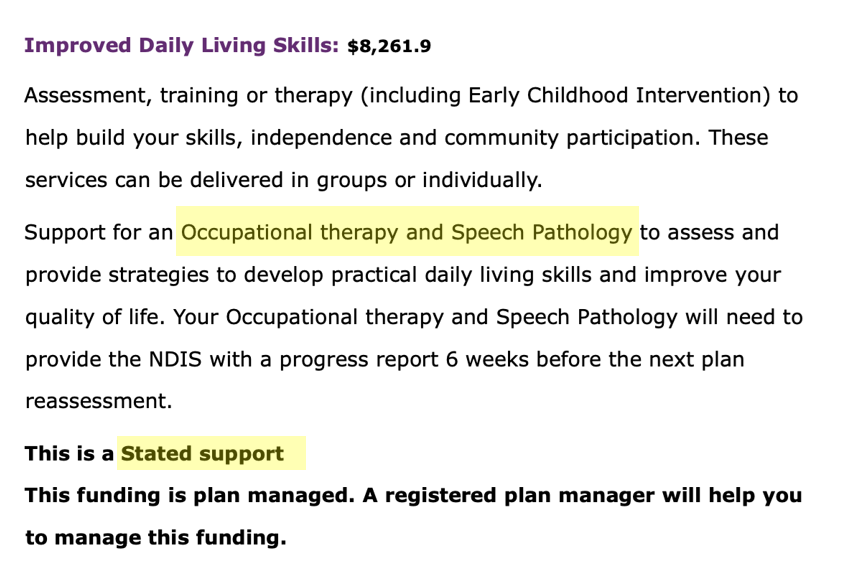 Image 1. Example of a stated budget under Improved Daily Living
Image 1. Example of a stated budget under Improved Daily Living
When I checked the NDIAs FAQ page on Friday, April 25th (don’t ask me what I was doing checking the FAQs on a public holiday…!) their advice indicated that stated supports are flexible within the support category even when there is information in the plan that describes what the support category budget is for (see Image 2). They went on to say that the participant still has the flexibility to use the funds for any support as long as it’s within the same support category.
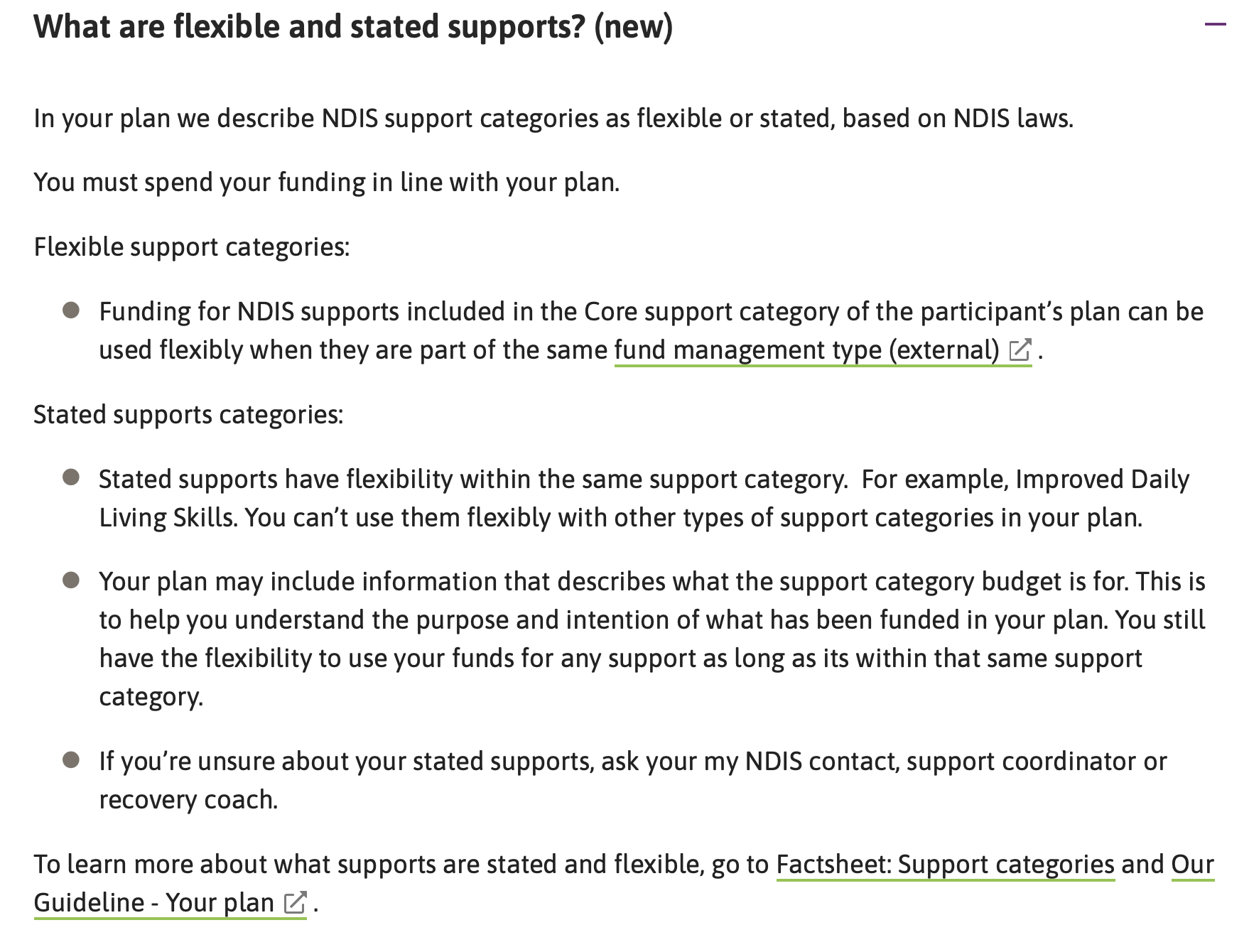 Image 2. NDIAs advice on stated supports. April 25th, 2025. Source: NDIS FAQs
Image 2. NDIAs advice on stated supports. April 25th, 2025. Source: NDIS FAQs
Come Monday, April 28th the NDIAs advice had completely shifted, now asserting both that stated supports are specifically described in the plan and that funding must be used exactly how it’s described in the plan (see Image 3).
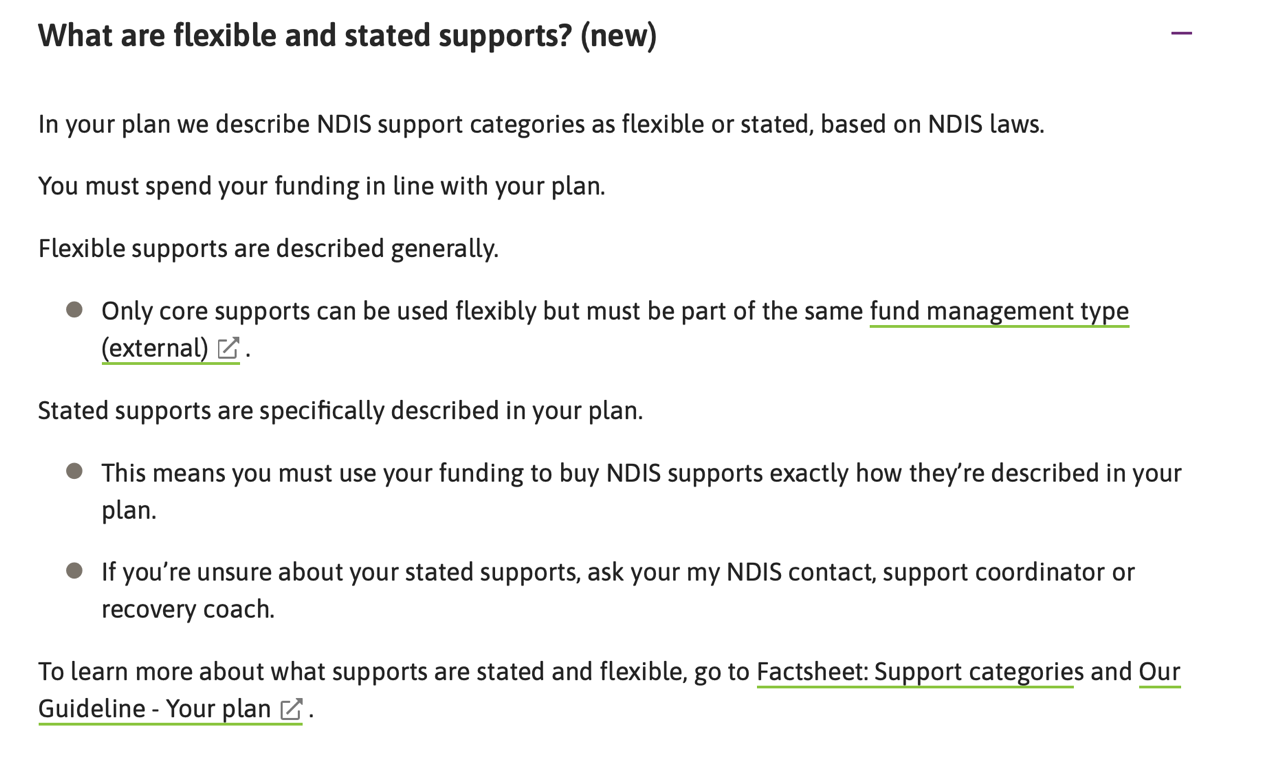 Image 3. NDIAs advice on stated supports. April 28th, 2025. Source: NDIS FAQs
Image 3. NDIAs advice on stated supports. April 28th, 2025. Source: NDIS FAQs
Just as we were adjusting to this policy shift, the April 28th explanation mysteriously vanished from the NDIA’s website. No explanation. No replacement. It was like it never existed.
Fast forward to July 16th the FAQ page once again says that stated supports are flexible within the support category even when there is information in the plan that describes what the support category budget is for and that the participant has the flexibility to use the funds for any support as long as it’s within the same support category. Phew! Clarity!
…Until July 17th, when that guidance also disappeared without a trace.
Fortunately, there are other sources we can look to for clarity in this area, including the ‘Using your NDIS plan factsheet’ (see Image 4) and the ‘What supports can you buy with your NDIS funding? Operational Guidelines (See Image 5). Both reinforce the NDIA’s April 28th advice that stated supports must be used as described in the plan. The factsheet is dated January 2025 and the Operational Guidelines dated October 2024. So admittedly, neither document is hot off the press, and in a fast-moving environment like the NDIS, that matters. But it’s the best we’ve got. And sometimes, this is the sort of forensic digging required to make sense of the rules.
While I can’t say with total certainty that this reflects the NDIA’s current position, the least risky approach is to use stated support funding exactly as set out in the plan.
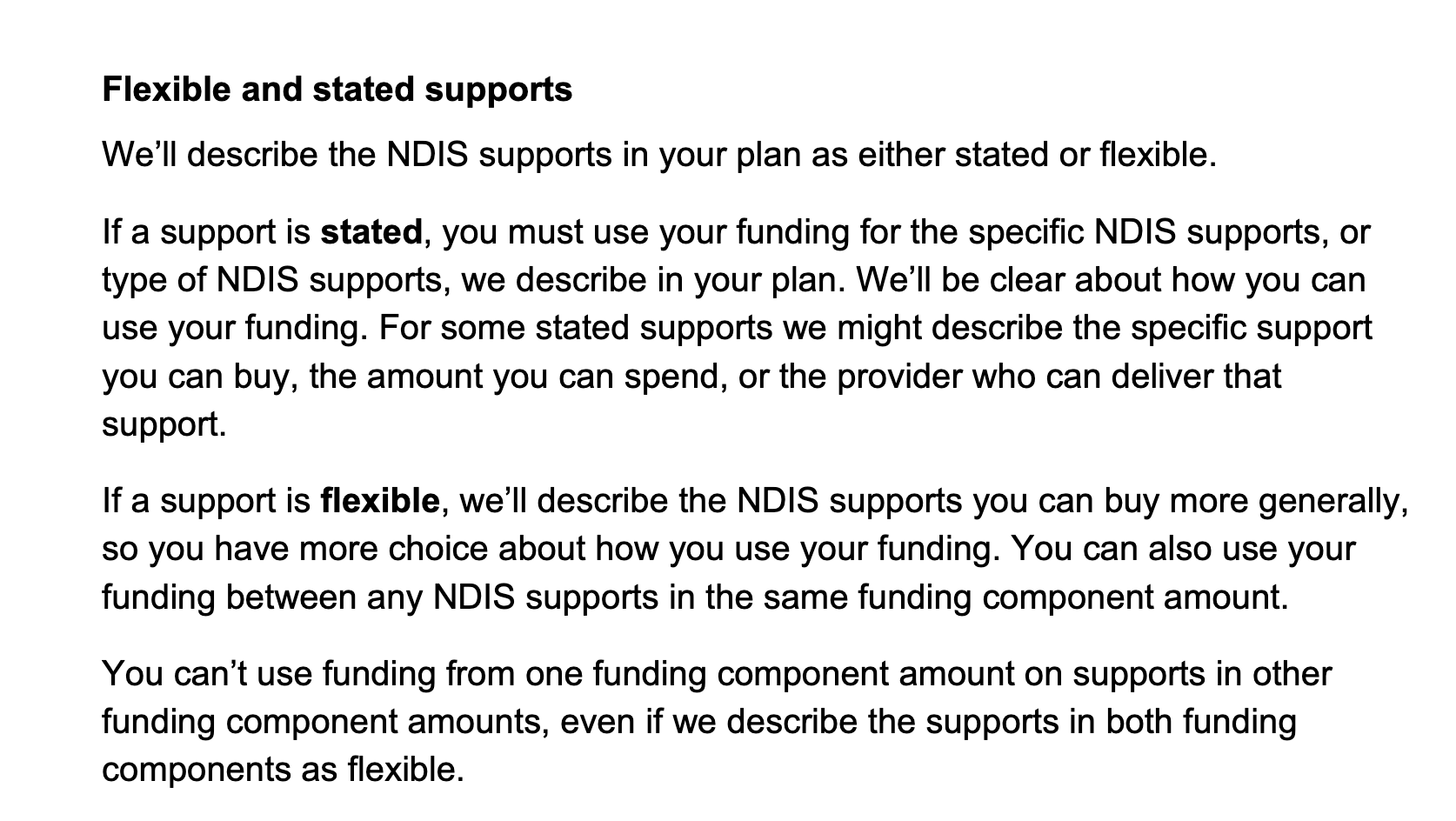
Image 4. Using your NDIS plan factsheet
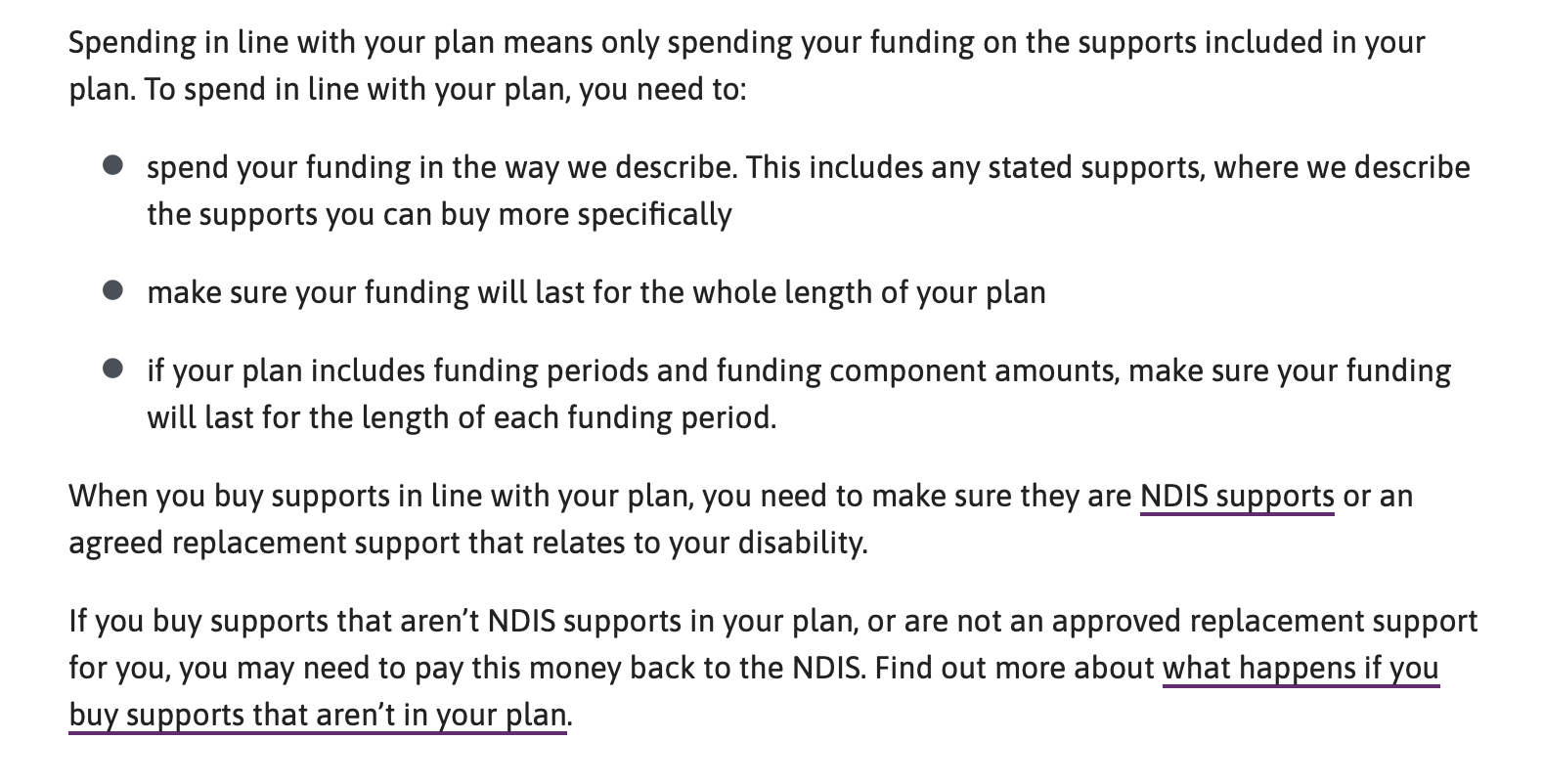 Image 5. What supports can you buy with your NDIS funding? Operational Guideline
Image 5. What supports can you buy with your NDIS funding? Operational Guideline
Either way, the inclusion of critical details for stated supports included in the body of a plan creates a particular challenge for providers, including Support Coordinators and Plan Managers because descriptive details are not included in the plan information published through PACE, they are only found in the participant’s actual plan document.
This means providers need to:
- clarify with participants whether any additional descriptions apply, and
- trust that participants are accurately reading their plan and sharing any relevant information.
Providers cannot insist that a participant share their full plan. As a result, there’s a risk that funding could accidentally be spent in a way that doesn’t align with the plan, and as explained below, that can lead to serious consequences.
The plan spells out particular requirements
Sometimes the plan will specifically say that:
- A certain provider must deliver the support,
- A particular qualified person must be used, or
- A support must be delivered in a certain way (e.g., by telehealth or in-person only).
In all these cases, the participant must follow the description to the letter.
A common misunderstanding
One myth that pops up regularly is that meal preparation and delivery must be stated in a plan- this is not true! Both the PAPL and the Operational Guidelines clarify that the NDIA does not require a quote for meal prep and delivery and it is not treated as a stated support.
In fact, both sources give an example where meal delivery services can be flexibly purchased from Core supports during short-term disruption, again, provided it meets the Can I Buy It? checklist criteria. You can read more about meal prep supports in our article: Food, meal prep and the NDIS: FAQs
Why this matters
Section 46 of the NDIS Act requires that funds are spent in line with the way supports are described in the plan.
When the NDIA believes someone is not spending in accordance with their plan, they can:
- Change the plan management type (for example, moving the participant from self-managed to agency-managed).
- Change the funding intervals (so the participant receives smaller amounts more often, rather than a full budget upfront).
- Raise a debt requiring either the participant or provider to repay funds incorrectly used.
Following the plan and using tools like the Can I Buy It? checklist helps participants stay on track and avoid serious headaches later.
A fuzzy zone
An area to watch closely is where a support is flexible but the plan includes detailed instructions.
For example, Short Term Accommodation (STA) is a flexible support under the Core Support Category. In some plans (such as the example below), the description may specify a particular ratio of support for STA (such as a group ratio rather than 1:1).
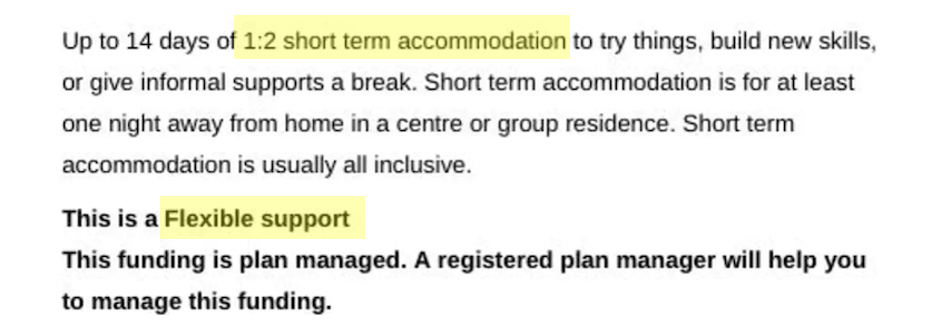 Image 6. Example of a flexible STA budget
Image 6. Example of a flexible STA budget
According to flexibility rules, participants are not required to spend these funds on STA. They could use the funds for alternatives like flexible in-home support or access to the community. However, if a participant chooses to purchase STA, it’s unclear whether purchasing it at a 1:1 ratio (instead of a group ratio) would breach spending “in line with the plan.”
One way to guide this decision is by applying the Can I Buy It? checklist.
The third checklist question asks:
“Is the cost of the support reasonable? The cost of the support should be reasonable when you think about the benefit of the support. It should give you good value for money compared to other options.”
In other words, it comes down to value for money.
If a participant chooses to purchase STA at a 1:1 ratio, they (and their provider) need to be confident they can justify it as value for money and be aware of the risks if the NDIA sees it differently.
Changing a stated support
In some cases, changes to a stated support can be made via a plan variation. A plan variation is when NDIA changes an existing NDIS plan without replacing it with a completely new plan.
Participants can request a plan variation if their circumstances have changed and the current description of the support no longer meets their needs. Requests can be made by contacting the NDIA directly or by using the Change of details or situation form.
More information about changing your plan can be found here and here.
Final tips
When reviewing a NDIS plan:
- Double-check what’s stated and what’s flexible.
- Carefully read any specific instructions about how the funding must be used.
- Use the Can I Buy It? checklist before providing services or making purchases with flexible funds.
- Get help early if anything seems unclear. Prevention is way better than trying to fix it later.
Because let’s be honest, in the world of the NDIS, advice can change faster than the weather at a Melbourne picnic. Stay sharp, stay curious, and stay ready to roll with the changes.
Keen to explore more? Check out our latest workshop on New Look NDIS Plans: What’s Flexible, What’s Stated, What’s Next.
:format(jpg))
